Executive Summary
Congress returns from its August recess Tuesday, September 5 with a long to-do list of legislative deadlines, including lifting the debt ceiling, funding the government beyond the end of September, reauthorizing a number of federal programs and passing a budget resolution to serve as the vehicle for changes to tax law. For the House of Representatives, there are just 12 scheduled legislative days in September to accomplish the to-do list. In this slightly longer edition of the Capitol Hill Update, we outline the legislative calendar and provide our views on how we believe federal fiscal policy will unfold in the month ahead.
Our expectation is that the debt ceiling will be lifted before the projected September 29 deadline. Given the need for a bipartisan vote in the Senate to lift the borrowing limit, we expect the debt ceiling will be suspended for a period of time without being tied to budget cuts or other policy changes. The federal funding bill will also require bipartisan support and thus we expect Congress will enact a continuing resolution that maintains this fiscal year’s funding levels through the beginning/middle of December, buying policymakers more time to work toward a solution for the remainder of the fiscal year. While tax reform discussions will be ongoing, we do not expect any major developments until late October or early November due to the numerous other pressing legislative priorities and the need to first pass a budget resolution.
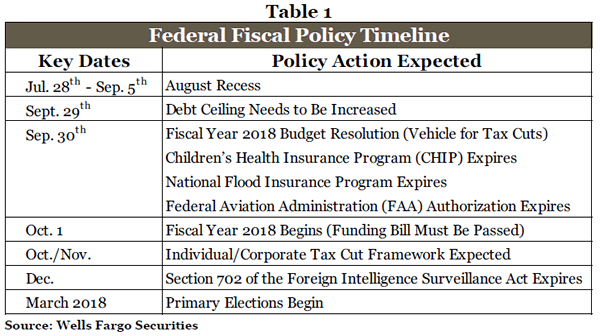
Debt Ceiling: Will There Be Strings Attached?
One of the biggest concerns among market participants is the need to lift the nation’s borrowing limit. Back in 2011, a down-to-the-wire vote resulted in volatile financial markets and a credit rating downgrade of U.S. sovereign debt. During this round of the debt ceiling debate, there have been demands by some fiscally conservative members of the House of Representatives to cut nondefense spending in exchange for lifting the debt ceiling. Other members of Congress have balked at this approach, preferring to pass a "clean" debt ceiling bill that does not tie the borrowing limit to other legislative items.
Given the fact that at least eight Democrats will need to join with Republicans in the Senate to advance the bill, it will require a bipartisan effort to raise the debt ceiling. A key question surrounding the debt ceiling debate is whether Democrats will demand concessions from Republicans to gain their votes. If fiscally conservative members begin to abandon ship in droves and Republican leadership must lean heavily on Democratic votes to pass a debt ceiling increase, it may empower the minority party to try to extract a hefty price from the party in power. If this was to occur, it would put Republican leadership in an awkward place; short of the necessary votes, and stuck between two sides both demanding concessions for their critical block of votes. The probability of a major market moving event in this case would likely increase, and we will be watching closely in the weeks ahead for signs that events are unfolding along this path.
Our view is that a "clean" debt ceiling bill with no other policy changes or budget cuts attached will be passed. There are just 12 legislative days scheduled in the House of Representatives before the September 29 deadline, suggesting that both the House and Senate must move quickly toward passage, limiting the ability to have a long, drawn out debate over other policy changes.1 This "clean" debt ceiling bill is likely to suspend the borrowing limit as has been done frequently in the recent past as opposed to increasing the borrowing limit to a specific dollar amount.
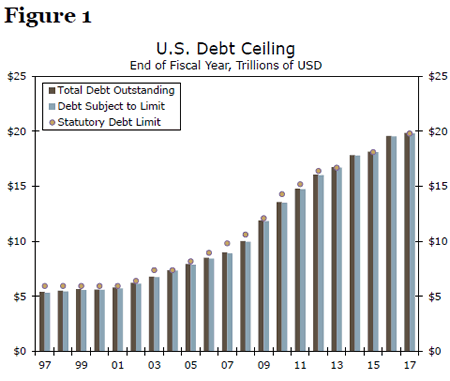
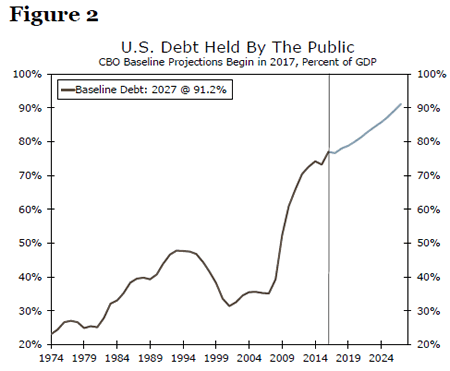
Federal Funding: Expect the Can to Be Kicked
The next major issue to tackle is funding the federal government beyond September 30. Should Congress fail to pass a funding bill, the result would be a partial federal government shutdown. In the case of a partial shutdown, the President’s Office of Management and Budget would develop a plan to determine which federal employees would be affected through furlough. The most likely outcome given the very short timeline entails passing a continuing resolution (CR) that funds the government through the first or second week in December. Once again, the CR will require at least eight Democrats to join with Republicans to keep the government functioning. This CR will likely carry over funding from the current 2017 fiscal year to keep the bill bipartisan and hopefully noncontroversial. We believe policymakers will likely turn to a shortterm patch because the regular appropriations process has been delayed as policymakers have grappled with other legislative items and difficult questions remained unresolved. Thus far, Republicans have pursued an aggressive expansion of defense spending while keeping nondefense spending more or less flat. Budget agreements over the past few years have often led a more bipartisan approach that provides bumps in funding to both defense and nondefense discretionary spending. If Democrats refuse to play ball in the Senate on a budget that abandons this balanced framework, or if a fight erupts over controversial budget items such as funding for a border wall, the appropriations process would likely continue to face major roadblocks throughout the fall.
Kicking the can to December will buy more time for a longer-term funding bill to be worked out in the remaining months of the year and allow Congress to turn to the other legislative deadlines it is facing in September, including the need to reauthorize the Federal Aviation Administration, the National Flood Insurance Program and the Children’s Health Insurance Program. Historically, reauthorizing these programs has at times been controversial and time consuming, requiring several weeks of debate to find solutions. This time around, we would not be surprised if these programs’ authorizations are also extended for a short period to buy time for continued negotiations and more comprehensive legislation.
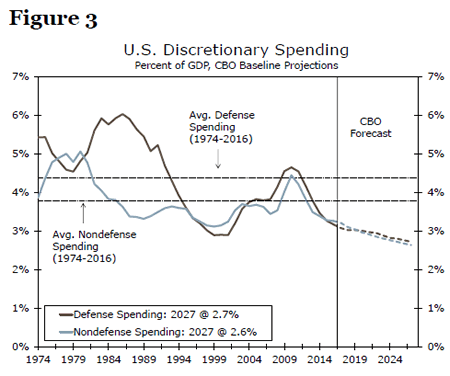
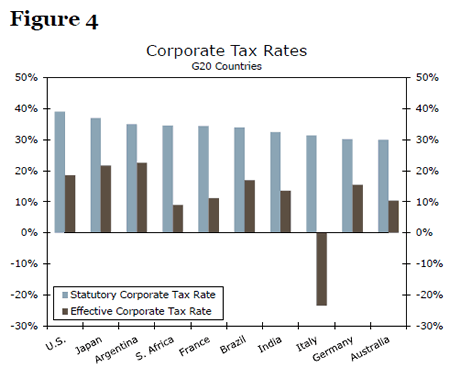
What about Tax Reform?
Given the multiple legislative deadlines facing Congress in September, as well as the fact that Republicans still need to pass a budget resolution before moving on to tax reform, we do not expect much progress on tax legislation until October or November. As we have described in previous pieces, the FY 2018 budget resolution is needed to proceed with the reconciliation process that will allow tax legislation to clear both chambers with a simple majority vote.2 Early signs are that the debate over a budget resolution could take some time. Fiscal conservatives in the House want more nondefense budget cuts, while more moderate members have resisted sharp cuts to nondefense discretionary and/or mandatory spending. Disagreements over balancing the budget/deficit size over the next decade have also plagued the budget resolution. For now, despite the optimistic rhetoric coming from Washington D.C. on taxes, we expect tax legislation will take a backseat in September to other more pressing federal fiscal policy items, such as the debt ceiling and government funding.













